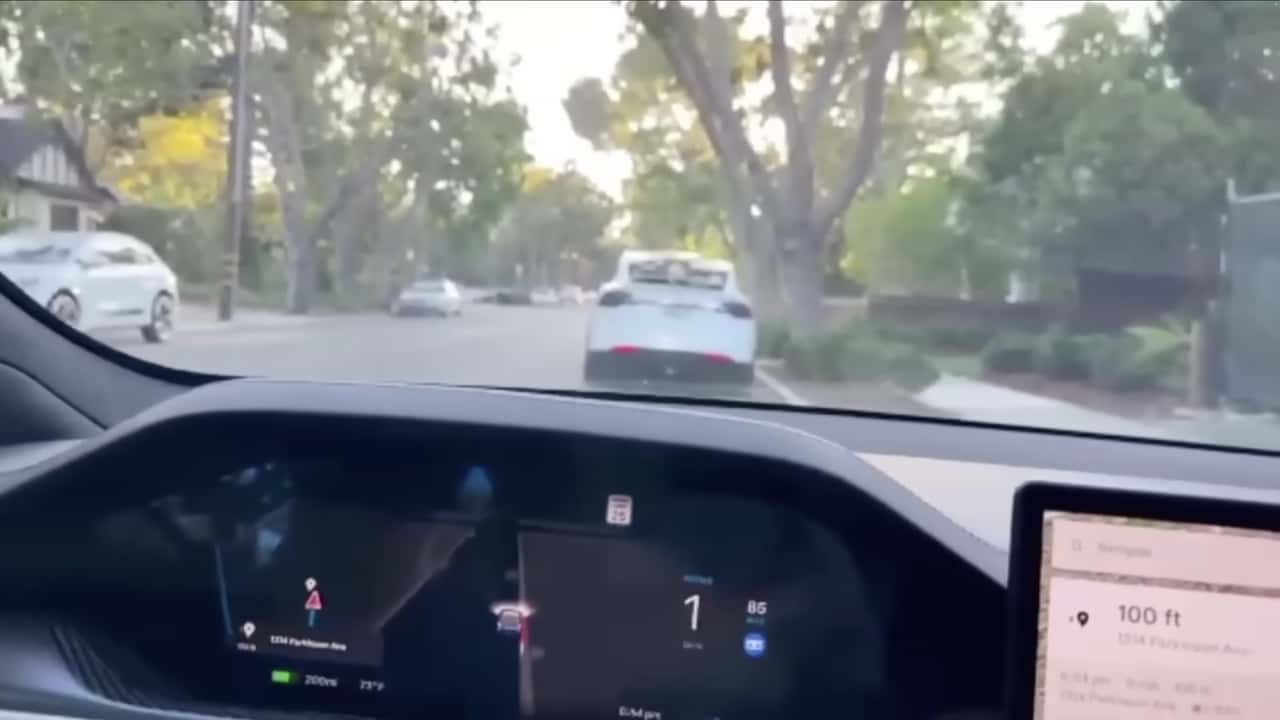Tesla’s latest update for its Full Self-Driving software (FSD V12) could potentially revolutionize semi-autonomous driving. CEO Elon Musk recently demonstrated the capabilities of the new software during a live stream on X (formerly Twitter), where he tested a Model S equipped with FSD V12. The demonstration showcased the significant progress Tesla has made in developing its AI-driven autopilot.
During the live stream, the video quality was pixelated, and Musk was seen behind the steering wheel of the Model S, recording with a phone in his hand. Ashok Elluswamy, the head of the autopilot software team, accompanied him. The electric sedan navigated the tree-lined streets of Palo Alto during rush hour, offering a glimpse into the advanced capabilities of the FSD V12.
Musk explained that Tesla’s FSD V12 functions similarly to the human brain, utilizing neural networks and its eight onboard cameras as its “eyes.” Unlike traditional coding, the system doesn’t rely on specific instructions to navigate various scenarios, such as slowing down for speed bumps or stopping at stop signs. Instead, it trains using data from millions of Tesla vehicles already on the roads worldwide, effectively mimicking human drivers.
The system’s cameras have a frequency rate of 36 frames per second, although they can theoretically run at 50 fps. Musk mentioned that test-driving is currently underway in different countries, including New Zealand, Thailand, Norway, and Japan. He emphasized the importance of extensive training data and the need for specialized hardware to run the neural net training.
The demonstration showcased the Model S’s ability to navigate roundabouts, stay within lanes, recognize pedestrians and cyclists, and make active decisions. Musk highlighted the differences between FSD V12 and its predecessor, V11, noting that V12’s explicit control stack doesn’t rely on lines of code to handle specific scenarios as V11 did.
However, the live stream also revealed some imperfections. At one intersection, the Model S slowed down at a stop sign but didn’t come to a complete halt, and it drove over the painted stop marker before continuing. Elluswamy explained that only 0.5 percent of humans actually stop at stop signs, citing data analyzed by Tesla. Musk acknowledged the need to train the system to obey stop signs as per regulatory requirements.
The demonstration also showed a moment of confusion when the system almost jumped a red light at a traffic stop, prompting Musk to intervene. This indicates that FSD V12 still requires further training to ensure its safety before it can be released for public use. Nonetheless, Musk expressed confidence in the system’s ability to “figure it out” and understand traffic signs without relying on text.
Overall, FSD V12 represents a significant leap forward in Tesla’s autonomous driving capabilities. While it still requires refinement, the system’s reliance on neural networks and extensive training data offers promising potential for the future of autonomous vehicles.
What We Learned from Tesla CEO Elon Musk’s Test Drive of FSD V12
Tesla CEO Elon Musk recently took to the roads to test drive the highly anticipated Full Self-Driving (FSD) version 12 software. As one of the most talked-about developments in autonomous driving technology, Musk’s test drive has drawn significant attention and provided valuable insight into the capabilities and potential of Tesla’s advanced driving system.
One of the key takeaways from Musk’s test drive is the impressive level of progress made by Tesla’s FSD software. Musk described the experience as “profound” and stated that the system had achieved “massive” improvements. This showcases the significant strides being made in autonomous driving technology, bringing us closer to a future where self-driving vehicles are commonplace on our roads.
Another important revelation from Musk’s test drive is the enhanced navigation and route-planning capabilities of the FSD V12 software. Musk mentioned that the car was able to navigate complex intersections, accurately interpret traffic signals, and even handle roundabouts seamlessly. These advancements indicate that Tesla’s autonomous driving system is rapidly approaching the level of human-like decision-making and response, making it a truly viable alternative to conventional driving.
Moreover, Musk underscored the increased awareness of the FSD V12 software, which now includes a range of additional sensory inputs, such as camera-based detection, that help the vehicle perceive and understand its surroundings more accurately. This comprehensive perception capability is crucial for the safe and efficient operation of self-driving vehicles in various scenarios and road conditions.
In terms of safety, Musk highlighted the improved accident avoidance capability of the FSD V12 software. During the test drive, the car successfully maneuvered around road hazards, including unexpected obstacles, parked vehicles, and pedestrians, further demonstrating the software’s enhanced ability to protect both drivers and passengers.
Despite the remarkable progress showcased during Musk’s test drive, it is crucial to maintain a realistic outlook on the limitations of current autonomous driving technology. Autonomous driving is an incredibly complex task, and achieving full self-driving capability under all conditions remains a significant challenge. Musk himself acknowledged that the system is not perfect, admitting that “sometimes it gets things wrong,” emphasizing the ongoing need to refine and improve the software.
Additionally, the regulatory landscape and public acceptance of autonomous vehicles pose significant hurdles to the widespread adoption of FSD technology. Policymakers, regulatory bodies, and the general public need to be assured of the safety, reliability, and ethical considerations associated with self-driving cars, thus requiring continued research, testing, and public dialogue.
In conclusion, Elon Musk’s test drive of Tesla’s FSD V12 software has provided valuable insights into the capabilities and potential of autonomous driving technology. The remarkable progress made in navigation, safety, and perception underscores the advancements being made in this field. However, it is essential to approach the development of self-driving technology with caution, understanding that there are still challenges to overcome before fully autonomous vehicles become a reality. Nonetheless, Musk’s test drive encourages optimism that the future of autonomous driving is within reach, enabling us to reimagine and reshape the way we travel.

